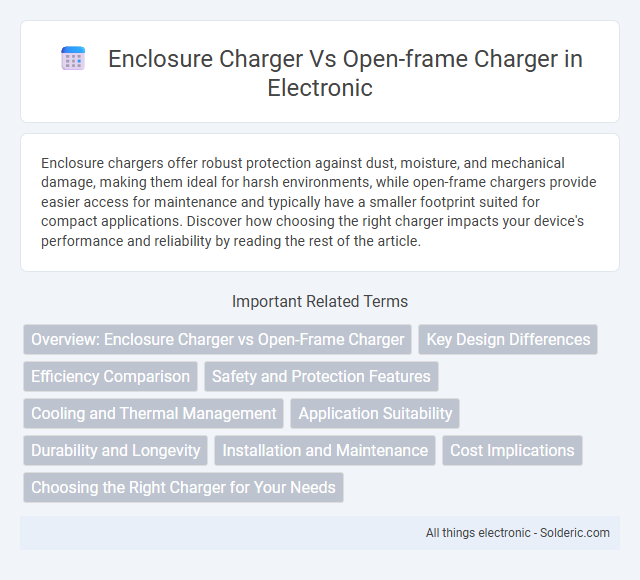Enclosure chargers offer robust protection against dust, moisture, and mechanical damage, making them ideal for harsh environments, while open-frame chargers provide easier access for maintenance and typically have a smaller footprint suited for compact applications. Discover how choosing the right charger impacts your device's performance and reliability by reading the rest of the article.
Comparison Table
| Feature | Enclosure Charger | Open-frame Charger |
|---|---|---|
| Design | Fully enclosed, protective casing | Exposed components, no casing |
| Durability | High resistance to dust, moisture, and physical damage | Lower protection; vulnerable to environmental factors |
| Cooling | Typically passive or fan-cooled inside enclosure | Better natural air circulation for heat dissipation |
| Applications | Indoor use, harsh environments, industrial settings | Controlled environments, OEM integration, prototyping |
| Size | Compact but with added enclosure bulk | Smaller footprint, flexible mounting options |
| Cost | Higher cost due to enclosure and assembly | Lower cost, simpler manufacturing |
| Maintenance | Less frequent; protected from dust and damage | Requires careful handling; exposed circuitry |
Overview: Enclosure Charger vs Open-Frame Charger
Enclosure chargers feature a protective casing that shields internal components from dust, moisture, and physical damage, enhancing durability and safety in various environments. Open-frame chargers offer a compact, lightweight design with exposed circuitry, allowing for easier customization and integration into systems where space and airflow are prioritized. Choosing between these charger types depends on specific application requirements such as environmental conditions, space constraints, and cooling needs.
Key Design Differences
Enclosure chargers are built with protective casings that safeguard internal components from dust, moisture, and physical damage, ensuring durability and safety in various environments. Open-frame chargers feature exposed circuit boards that allow for easier customization and cooling but require external protection when used in harsh conditions. Your choice depends on application needs, balancing protection requirements with design flexibility and thermal management.
Efficiency Comparison
Enclosure chargers typically offer higher efficiency due to better thermal management and robust shielding that reduces electromagnetic interference, enhancing overall performance. Open-frame chargers, while cost-effective and compact, often experience lower efficiency rates because of exposed components leading to heat dissipation challenges. Efficiency in enclosure chargers generally ranges from 85% to 95%, surpassing open-frame models which usually operate between 75% and 90%.
Safety and Protection Features
Enclosure chargers provide enhanced safety and protection features by housing components within a robust casing, preventing accidental contact and shielding against dust, moisture, and mechanical damage. Open-frame chargers lack a protective enclosure, increasing the risk of electrical hazards and exposure to environmental factors, which may compromise device reliability and user safety. Choosing an enclosure charger ensures your equipment benefits from superior insulation, short-circuit protection, and compliance with safety standards, essential for sensitive or high-power applications.
Cooling and Thermal Management
Enclosure chargers offer robust cooling solutions through integrated heat sinks and fan systems, ensuring efficient thermal dissipation within a sealed environment, ideal for applications requiring dust and moisture protection. Open-frame chargers rely on natural air convection and optional external cooling components, benefiting from increased airflow but demanding careful placement to avoid overheating. Effective thermal management in enclosure chargers extends device lifespan by maintaining stable internal temperatures, whereas open-frame designs require vigilant environmental control to prevent thermal stress.
Application Suitability
Enclosure chargers provide robust protection against dust, moisture, and physical impact, making them ideal for industrial and outdoor applications where environmental hazards are a concern. Open-frame chargers offer greater flexibility in integration within compact electronic devices, suited for controlled environments like consumer electronics or embedded systems. Selecting between these chargers depends on the operational environment, with enclosure chargers favored for rugged conditions and open-frame chargers preferred for space-constrained, clean settings.
Durability and Longevity
Enclosure chargers provide enhanced durability and longevity by protecting internal components from dust, moisture, and physical damage, making them ideal for harsh environments. Open-frame chargers, while typically more cost-effective and easier to service, lack protective housing which can reduce lifespan when exposed to contaminants or mechanical stress. Choosing the right charger depends on your application's environmental demands and the importance of long-term reliability.
Installation and Maintenance
Enclosure chargers provide enhanced protection against dust, moisture, and mechanical damage, simplifying installation in harsh or industrial environments by requiring less frequent maintenance. Open-frame chargers offer easier access to internal components, facilitating quicker repairs and routine inspections, which can reduce downtime during maintenance. Choosing between enclosure and open-frame chargers depends on the operational environment and maintenance priorities, with enclosure chargers favored for durability and open-frame chargers preferred for serviceability.
Cost Implications
Enclosure chargers often involve higher upfront costs due to their robust protective casing, which adds to manufacturing and material expenses. Open-frame chargers, with a simpler design and fewer materials, tend to be more cost-effective, making them suitable for budget-conscious applications. Choosing between them impacts your overall investment, balancing durability with budget constraints in power supply solutions.
Choosing the Right Charger for Your Needs
Enclosure chargers provide a fully protected, compact solution ideal for environments requiring dust and moisture resistance, while open-frame chargers offer easier access for maintenance and flexible installation in controlled settings. Selecting the right charger depends on your specific application needs, environmental conditions, and space constraints. Your choice impacts durability, cooling efficiency, and overall system reliability.
Enclosure charger vs Open-frame charger Infographic

 solderic.com
solderic.com